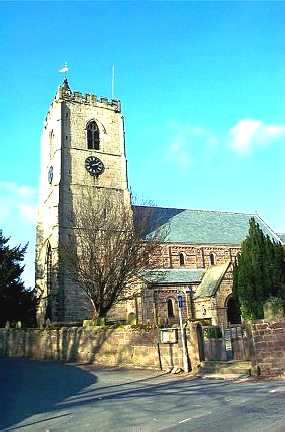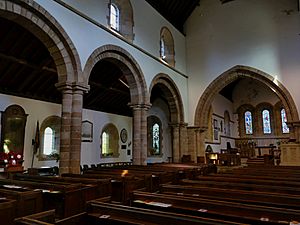All Saints' Church, Spofforth, North Yorkshire facts for kids
Quick facts for kids All Saints' Parish Church |
|
|---|---|

All Saints' Church
|
|
| 53°57′16.2″N 1°26′45″W / 53.954500°N 1.44583°W | |
| OS grid reference | SE 36464 51079 |
| Location | Spofforth, North Yorkshire |
| Country | England |
| Denomination | Church of England |
| Churchmanship | Central |
| Administration | |
| Parish | Spofforth and Kirk Deighton |
| Diocese | Leeds |
| Province | York |
All Saints Church is a historic Anglican church located in the villages of Spofforth and Kirk Deighton in North Yorkshire, England. It is a special place where people have worshipped for many centuries.
Contents
The Church's Long History
Early Beginnings and Changes
The oldest parts of All Saints Church were built a very long time ago, during the Norman era. This was a period in English history after the Normans came to England in 1066. The church was made bigger in the 1400s. However, these larger parts were later thought to be too much after another church was built nearby in Wetherby.
So, the church was changed again in 1854 and 1855. A person named JW Hugall helped with this work. During this time, the main parts of the church, called the nave and chancel, were changed back to look more like the original Norman style.
Joining Parishes and Dioceses
In 1971, several church areas, known as parishes, joined together. These included Spofforth, Kirk Deighton, Follifoot, and Little Ribston. They formed a new, larger parish called Spofforth and Kirk Deighton. This new parish was part of the Diocese of Ripon. A diocese is like a large church district led by a bishop.
Later, in 2014, the parish moved to a different church district, the Diocese of Leeds.
Famous People Connected to the Church
A famous road-builder named John Metcalf is buried in the churchyard. He lived from 1717 to 1810 and was known for building roads even though he was blind.
The Church Building Itself
The church buildings are very important and are listed as Grade II* listed. This means they are special historic buildings. Most of what you see today was built during the changes made in 1854 and 1855.
However, the church tower is much older, dating back to the 1400s. Inside the tower, there are four bells. Three of these bells are also very old, made in the late 1500s or early 1600s.
See also


